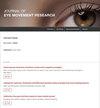Predictive models of reading difficulties considering neuropsycholinguistic profiles of atypical and ADHD-inattentive type readers, and eye-tracking measures
IF 1.3
4区 心理学
Q3 OPHTHALMOLOGY
引用次数: 0
Abstract
This study reports on several specific neurocognitive processes and eye-tracking predictors of reading outcomes for a sample of children with Developmental Dyslexia (DD) and Attention-Deficit/Hyperactivity Disorder – inattentive subtype (ADHD-I) compared to typical readers. Participants included 19 typical readers, 21 children diagnosed with ADHD-I and 19 children with DD. All participants were attending 4th grade and had a mean age of 9.08 years. The psycholinguistic profile of each group was assessed using a battery of neuropsychological and linguistic tests. Participants were submitted to a silent reading task with lexical manipulation of the text. Multinomial logistic regression was conducted to evaluate the predictive capability of developing dyslexia or ADHD-I based on the following measures: (a) a linguistic model that included measures of phonological awareness, rapid naming, and reading fluency and accuracy; (b) a cognitive neuropsychological model that included measures of memory, attention, visual processes, and cognitive or intellectual functioning, and (c) an additive model of lexical word properties with manipulation of word-frequency and word-length effects trough eye-tracking. The additive model in conjunction with the neuropsychological model classification improved the prediction of who develops dyslexia or ADHD-I having as baseline normal readers. Several of the neuropsychological and eye-tracking variables have power to predict the degree of reading outcomes in children with learning disabilities.阅读困难的预测模型:考虑非典型阅读者和多动症注意力不集中型阅读者的神经心理语言学特征以及眼动跟踪测量结果
本研究报告了发育性阅读障碍(DD)和注意力缺陷/多动障碍--注意力不集中亚型(ADHD-I)儿童样本与典型阅读者相比的几种特定神经认知过程和眼动跟踪对阅读结果的预测。参与者包括 19 名典型阅读者、21 名被诊断患有 ADHD-I 的儿童和 19 名患有发展性阅读障碍的儿童。所有参与者均为四年级学生,平均年龄为 9.08 岁。我们通过一系列神经心理学和语言学测试评估了每组儿童的心理语言学特征。受试者接受了默读任务,并对文本进行了词汇操作。通过多项式逻辑回归,根据以下指标评估了患阅读障碍或多动症Ⅰ的预测能力:(a) 语言模型,包括语音意识、快速命名、阅读流畅性和准确性的测量;(b) 认知神经心理学模型,包括记忆、注意力、视觉过程、认知或智力功能的测量;(c) 词汇属性的加法模型,通过眼动跟踪对词频和词长效应进行处理。加法模型与神经心理学模型分类相结合,提高了对以正常读者为基线的阅读障碍或多动症Ⅰ患者的预测能力。一些神经心理学变量和眼动跟踪变量可以预测学习障碍儿童的阅读效果。
本文章由计算机程序翻译,如有差异,请以英文原文为准。
求助全文
约1分钟内获得全文
求助全文
来源期刊

Journal of Eye Movement Research
OPHTHALMOLOGY-
CiteScore
2.90
自引率
33.30%
发文量
10
审稿时长
10 weeks
期刊介绍:
The Journal of Eye Movement Research is an open-access, peer-reviewed scientific periodical devoted to all aspects of oculomotor functioning including methodology of eye recording, neurophysiological and cognitive models, attention, reading, as well as applications in neurology, ergonomy, media research and other areas,
 求助内容:
求助内容: 应助结果提醒方式:
应助结果提醒方式:


